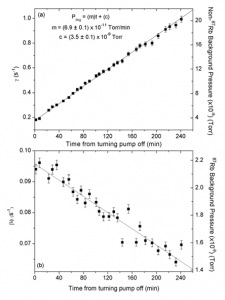Vacuum Studies with Cold Atoms
The capture of N atoms from background vapour in a Magneto-Optical Trap (MOT) obeys an exponentially-decaying growth as a function of time t:
N (t) = Neq [1 – exp(-t/τ)].
By plotting the values of the equilibrium number of trapped atoms Neq as a function of the loading time-constant τ for varying vacuum conditions, useful information can be gained about the experimental setup. We use this approach for two different purposes: to characterise MOT-loading using the light-induced atomic desorption technique and to
measure vacuum pressure using a MOT.
In recent years, light-induced atomic desorption (LIAD) of alkali atoms from the inner surface of a vacuum chamber has been employed in cold atom experiments for the purpose of modulating the alkali background vapour. This is beneficial because larger trapped atom samples can be loaded from vapour at higher pressure, after which the pressure is reduced to increase the lifetime of the sample. Using Neq-τ curves we performed a comprehensive analysis, based on the case of rubidium atoms adsorbed on pyrex, of various aspects of LIAD that are useful for this application. We studied the intensity dependence of LIAD by fitting the experimental data with a rate-equation model, from which we extracted a correct prediction for the increase in trapped atom number. Following this, we introduced a quantitative figure of merit for the utility of LIAD in cold atom experiments. We found that this figure of merit has a strict upper-limit which is useful in determining whether LIAD is a beneficial technique in any individual apparatus [1].
Secondly, the lifetime of an atom trap is often limited by the presence of residual background gases in the vacuum chamber. This leads to the lifetime being inversely proportional to the pressure. We use this dependence to estimate the pressure and to obtain pressure rate-of-rise curves by performing Neq-τ analyses. These pressure-rise curves are commonly used in vacuum science to evaluate the performance of a system. We observed different rates of pressure increase in response to different levels of outgassing in our system. Therefore we suggest that this is a sensitive method which will be useful in applications of cold atom systems, in particular where the inclusion of a standard vacuum gauge is impractical [2].
[1] L. Torralbo-Campo, G. D. Bruce, G. Smirne and D. Cassettari, Sci. Rep. 5, 14729 (2015)
[2] R. W. G. Moore, L. A. Lee, E. A. Findlay, L. Torralbo-Campo, G. D. Bruce and Donatella Cassettari, Rev. Sci. Instrum. 86 093108 (2015)
Current Team: G D Bruce, D Cassettari


